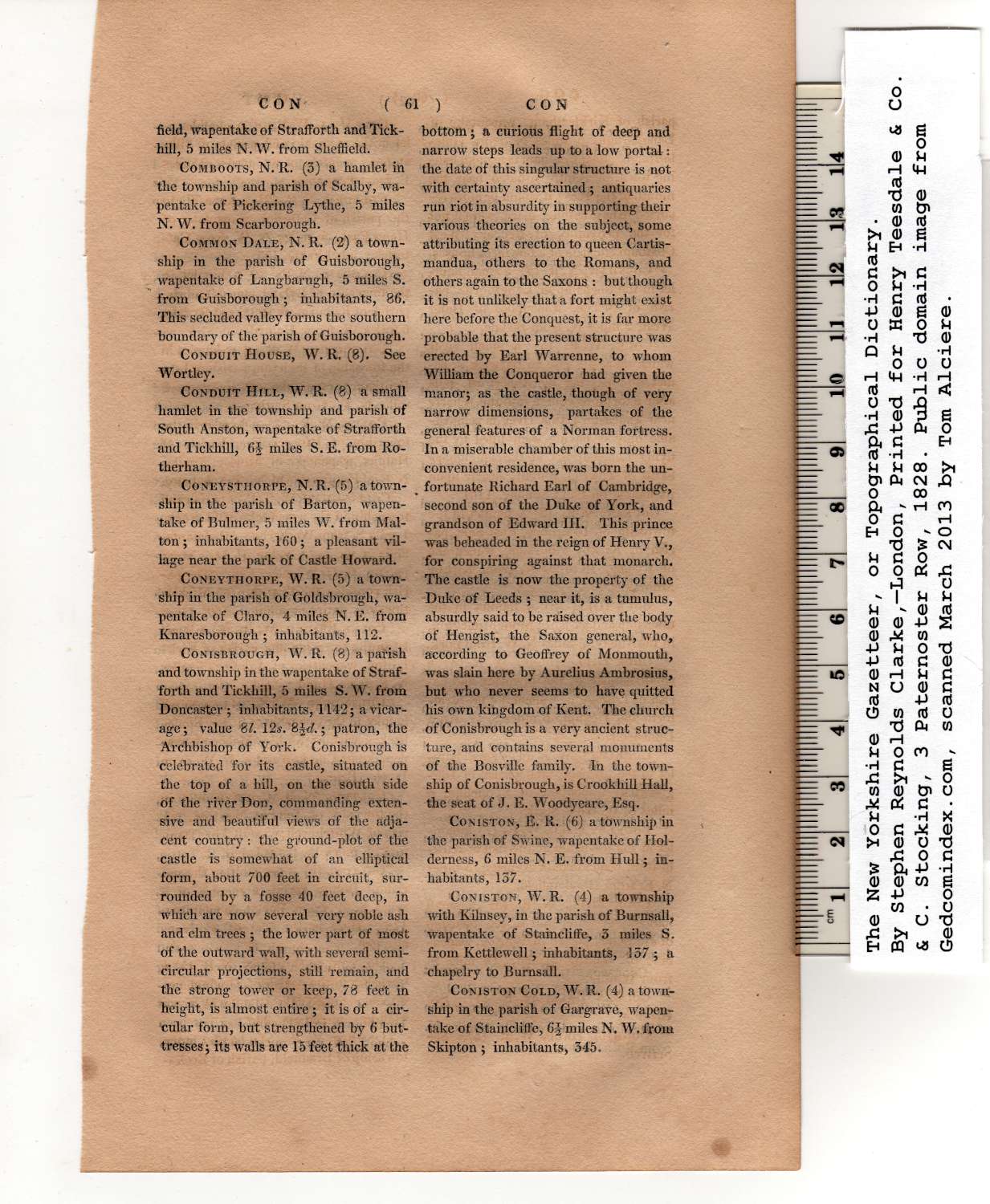|
field, wapentake of Strafforth and Tick-
hill, 5 miles N.W. from Sheffield.
Comboots, N.R. (3) a hamlet in
the township and parish of Scalby, wa-
pentake of Pickering Lythe, 5 miles
N. W. from Scarborough.
Common Dale, N. R. (2) a town-
ship in the parish of Guisborough,
wapentake of Langbarugh, 5 miles S.
from Guisborough; inhabitants, 86.
This secluded valley forms the southern
boundary of the parish of Guisborough.
Conduit House, W. R. (8). See
Wortley.
Conduit Hill, W. R. (8) a small
hamlet in the township and parish of
South Anston, wapentake of Strafforth
and Tickhill, 6§ miles S. E. from Ro-
therham.
Coneysthorpe, N. R. (5) a town-
ship in the parish of Barton, wapen-
take of Bulmer, 5 miles W. from Mal-
ton; inhabitants, 160; a pleasant vil-
lage near the park of Castle Howard.
Coneythorpe, W. R. (5) a town-
ship in the parish of Goldsbrough, wa-
pentake of Claro, 4 miles N. E. from
Knaresborough ; inhabitants, 112. |
Conisbrough, W. R. (8) a parish
and township in the wapentake of Straf-
forth and Tickhill, 5 miles S. W. from
Doncaster ; inhabitants, 1142; a vicar-
age ; value 8/. 12s. %id.; patron, the
Archbishop of York. Conisbrough is
celebrated for its castle, situated on
the top of a hill, on the south side
of the river Don, commanding exten-
sive and beautiful views of the adja-
cent country: the ground-plot of the
castle is somewhat of an elliptical
form, about 700 feet in circuit, sur-
rounded by a fosse 40 feet deep, in
which are now several very noble ash
and elm trees ; the lower part of most
of the outward wall, with several semi-
circular projections, still remain, and
the strong tower or keep, 78 feet in
height, is almost entire; it is of a cir-
cular form, but strengthened by 6 but-
tresses; its walls are 15 feet thick at the
bottom; a curious flight of deep and
narrow steps leads up to a low portal:
the date of this singular structure is not
with certainty ascertained; antiquaries
run riot in absurdity in supporting their
various theories on the subject, some
attributing its erection to queen Cartis-
mandua, others to the Romans, and
others again to the Saxons : but though
it is not unlikely that a fort might exist
here before the Conquest, it is far more
probable that the present structure was
erected by Earl Warrenne, to whom
William the Conqueror had given the
manor; as the castle, though of very
narrow dimensions, partakes of the
general features of a Norman fortress.
In a miserable chamber of this most in-
convenient residence, was born the un-
fortunate Richard Earl of Cambridge,
second son of the Duke of York, and
grandson of Edward III. This prince
was beheaded in the reign of Henry V.,
for conspiring against that monarch.
The castle is now the property of the
Duke of Leeds ; near it, is a tumulus,
absurdly said to be raised over the body
of Hengist, the Saxon general, who,
according to Geoffrey of Monmouth,
was slain here by Aurelius Ambrosius,
but who never seems to have quitted
his own kingdom of Kent. The church
of Conisbrough is a very ancient struc-
ture, and contains several monuments
of the Bosville family. In the town-
ship of Conisbrough, is Crookhill Hall,
the seat of J. E. Woodyeare, Esq.
Coniston, j£. R. (6) a township in
the parish of Swine, wapentake of Hol-
derness, 6 miles N. E. from Hull; in-
habitants, 157.
Coniston, W.R. (4) a township
with Kilnsey, in the parish of Burnsall,
wapentake of Staincliffe, 3 miles S.
from Kettlewell; inhabitants, 337 ; a
ehapelry to Burnsall.
Coniston Cold, W. R. (4) a town-
ship in the parish of Gargrave, wapen-
take of Staincliffe, 6§ miles N. W. from
Skipton; inhabitants, 345. |
